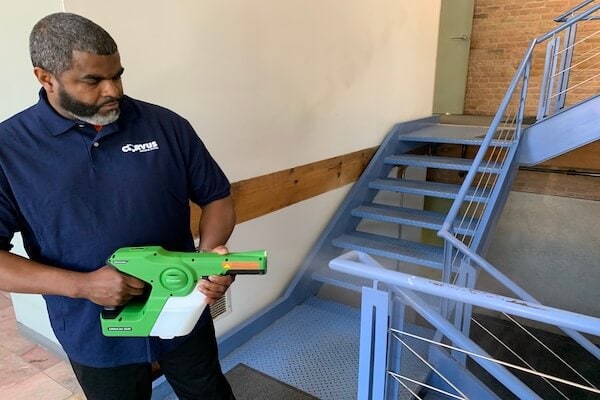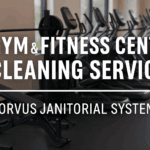Corvus Janitorial System and its Franchisees have been honored to participate in the fight against COVID. We are working to make workspaces clean, healthy, and safe. In an ongoing effort to support that mission, Corvus is pleased to announce its HIGH IMPACT DISINFECTING program. This disinfection process is centered around the use of ELECTROSTATIC SPRAYING systems, a highly effective technique employed to attack germs, bacteria, and viruses. Already in use by major airlines to disinfect planes between flights and also employed by medical and hospital type environments, Corvus is thrilled to bring this service offering to our valued customers.
What is Electrostatic Spraying?
Electrostatic spraying is a method of applying a coating, cleaner, disinfectant, or other liquid to a surface by applying an electric charge to the liquid solution. Electrostatic spray technology was invented in the 1930s to improve spray disposition. It was popularized in the 1940s by the auto industry, where it was used to more efficiently paint cars and trucks. In the 1980s, the technology emerged in the agriculture industry as a method to apply pesticides to crops. Over the last few years, electrostatic spray technology has found its way into the cleaning industry as an efficient new way for cleaning professionals to apply cleaners, sanitizers, and disinfectants across facility types and surfaces.
How Does Electrostatic Spraying Work?
At the most basic level, electrostatic spraying works by applying a positive electric charge to a liquid as it passes through a nozzle. The liquid is then sprayed onto a surface that is grounded or has a negative electric charge. Excess protons in the positively charged atoms of the spray are attracted to the electron fields of other atoms, causing those atoms to become polarized.
As Coulomb’s Law states, opposite charges are attracted to one another and similar charges repel each other. In essence, this means that a positively charged liquid is attracted to a neutral or negatively charged target surface. At the same time, as each particle of the liquid carries a positive charge, the particles naturally repel each other, creating a wider dispersion. As the liquid passes through the nozzle, it becomes atomized into a fine spray. The droplets disperse from each other, becoming finer and finer, and seek out a negatively charged surface to bind with.
Electrostatic spraying provides a full, even coat of liquid across a surface. The droplets will cover the entire visible area, including the underside and backside of surfaces. Surfaces that have already been covered by the disinfectant will repel additional spray, maximizing the efficiency of delivery. Conventional sprayers use air pressure to break down the particles in a liquid solution. This leads to a high spraying velocity that can cause overspray. Electrostatic sprayers do not use air pressure in the atomization process. This leads to a vastly improved transfer efficiency, which limits chemical consumption as well as the release of volatile organic compounds (VOCs) and hazardous air pollutants (HAPs) into the environment.
Electrostatic Spraying vs Traditional Disinfecting Techniques
Electrostatic spray technology provides many advantages during the disinfection process. In order to properly disinfect a surface, it must be fully coated with the disinfectant and needs to remain wet for the proper dwell time, usually around 10 minutes. Traditional methods of disinfecting, such as spray and wipe, mopping, and cloth applications are not only time consuming – they also lend themselves to human error. To truly disinfect an area, all surfaces must be disinfected. Traditional disinfection methods require the cleaner to manually apply and remove the chemicals, which can take a lot of time and requires acute attention to detail. Additionally, hard to reach areas are often overlooked, though they could still be soiled and carry dangerous germs and pathogens.
Electrostatic sprayers eliminate these barriers to effective disinfection. Because they are able to cover a large surface area relatively quickly, they are both time and monetarily efficient. Surfaces that are hard to reach by the human hand are easily reached by an electrostatic sprayer. This enables cleaning professionals to disinfect every surface in a room rather than just “high-touch” areas. Traditional disinfection methods, particularly spray and wipe, are rendered ineffective if the disinfectant is not allowed to dwell on a surface long enough.
Oftentimes, a surface will get sprayed with a disinfectant and wiped down almost immediately. This is a problem, as disinfectants need time to work properly. The proper dwell time varies by chemical, but 10 minutes is a good rule of thumb to reference. Disinfectants applied with an electrostatic sprayer solve the problem of inadequate dwell times. After applying disinfectant with an electrostatic sprayer, the surface does not need to be wiped down. In facilities such as childcare facilities, schools, and healthcare facilities where germs can spread like wildfire. Disinfection is of utmost importance to them, and electrostatic disinfection techniques are a game-changer.
Electrostatic Spraying in the Cleaning Industry
As mentioned above, traditional disinfecting spray equipment and methods come with a suite of issues. In addition to allowing for a proper dwell time, making hard to reach areas easily accessible, and shortening the time it takes to disinfect an area, electrostatic spray technology also addresses transfer efficiency problems. Transfer efficiency is a measure of how much chemical reaches a surface versus the percentage lost to the floor and surrounding environment. Just as the agricultural industry adapted electrostatic spray technology from the auto and painting industries, the commercial cleaning industry has adapted it to suit its needs. Because almost any liquid can be electrically charged, electrostatic sprayers are highly versatile in their applications.
With improvements in the past decade in the portability and simplicity of use of electrostatic sprayers, they have become a reasonable, cost-effective, and practical tool for professional cleaners to add to their arsenals. Cleaners, sanitizers, deodorizers, and disinfectants can all be used with electrostatic sprayers. In the current pandemic climate, there has been a massive surge in interest and demand for electrostatic disinfection services. Many companies are utilizing the technology to keep their businesses running and their stakeholders safe. For example, United Airlines has implemented electrostatic spray disinfection on their aircrafts after each flight.
Disinfectants Used in Electrostatic Sprayers
Since most liquids can be used in electrostatic sprayers, many common disinfectants can be applied using the technology. For use against COVID-19 specifically, the EPA has released “List N: Disinfectants for Use Against SARS-CoV-2”. All of the products on List N meet the EPA’s criteria for use against COVID-19. At Corvus, we use the hospital-grade disinfectant Q.T. Plus, which has demonstrated effectiveness on hard, porous surfaces against viruses similar to the 2019 novel coronavirus.
Conclusion
At Corvus Janitorial Systems, we understand that a clean and sanitary workplace not only protects people’s health. It also gives them peace of mind. With these needs in mind, Corvus has implemented the use of electrostatic sprayers into our service offerings. Call or email today to learn more about this exciting and effective service offering.
About Corvus Janitorial Systems
Founded in 2004 to make people’s lives better, Corvus is a full-service commercial cleaning franchisor that offers cleaning services through reputable local Franchisees. Corvus has been guided by its mission to transform people and transform places by consistently delivering independence, security, and freedom to Franchisees who deliver high-quality cleaning to offices, educational buildings, medical buildings/offices, recreational centers, industrial parks, and other spaces. The company has 17 regional support offices across the United States with nearly 900 Franchisees. For more information regarding Corvus, visit corvusjanitorial.com or corvusjanitorial.com/franchise for franchise information.













